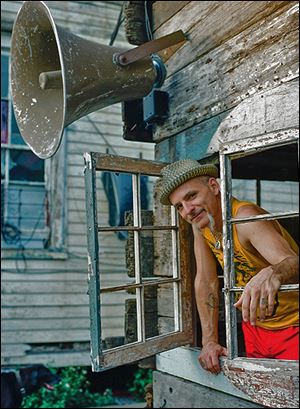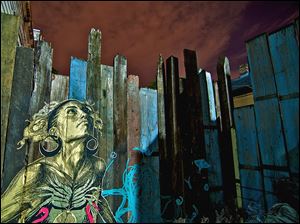
Owners use abodes as their canvases, with little damage to property values
8/31/2013
Richard Ormbrek’s Seattle home, which is decorated with a 20-foot-wide American flag made up of 180 painted tiles, has become a local landmark. He says that rather than hurt property values, his one-of-a-kind home gets offers from would-be buyers every week.
ASSOCIATED PRESS

Richard Ormbrek’s Seattle home, which is decorated with a 20-foot-wide American flag made up of 180 painted tiles, has become a local landmark. He says that rather than hurt property values, his one-of-a-kind home gets offers from would-be buyers every week.
SEATTLE — It’s hard to miss the huge 20-foot-wide American flag on the side of Richard Ormbrek’s home. Composed of about 180 tiles painted with scenes of Americana against a background of red and white stripes, the flag pops from the orange cedar shingles with traffic-stopping audacity.

Jay Pennington, associate curator of ‘The Music Box,’ a temporary community art project built in the yard of a homeowner in New Orleans, says neighbors appreciate the project.
This is actually the second major art project that Mr. Ormbrek has put on the house he shares with brother-in-law Bruce Edenso. The first — a traditional Haida Indian totem house design that covered the entire side of the home — was painted in 1975 and made the house something of a local landmark.

This undated photo provided by courtesy of New Orleans Airlift, shows a detail of Brooklyn street artist, Swoon's "Thalassa" print wheat-pasted on a section of fence in New Orleans.
Many people know of one: that neighborhood house that’s quirky or dramatic or a bona fide art project. But few have the inclination — or the guts — to turn their own home into “that house,” to view their property as a giant canvas waiting to be explored.
“We needed to paint our house anyway,” says Mr. Ormbrek. “And while we were mulling over the color, we decided to make our home look like a longhouse.”
Mr. Ormbrek’s late wife Judy, a Tlingit-Haida, picked the totem design.
Neighbors gaped as the house was transformed, but only one seemed to mind, fearing it would bring down property values. So far, it seems, the Totem House has neither driven down property values in one of Seattle’s hottest neighborhoods, nor affected the resale value of the home itself.
“I get offers every week to buy my home,” says Mr. Ormbrek. “Of course I’m not planning on selling the house.”
Keith Wong, an agent in San Gabriel, Calif., for the national real-estate brokerage Redfin says a home’s price and location are more important than aesthetics in tight markets.
“We educate our clients to look past cosmetics,” says Mr. Wong. “If a house has good bones, it has lots of potential.”
Mr. Wong recently took clients to see an unusual home in the Highland Park neighborhood of Los Angeles and says the couple were turned off more by the noise from a nearby freeway than by the home’s eclectic design, which included a rainbow of exterior colors and a giant statue of an insect in the front yard.
For those considering a creative makeover to their home, remember it’s a fine line between special and tacky, Mr. Wong advises. And consider how long you’ll be staying there.
“If you’re planning on selling your home anytime soon, it’s best to stick to cosmetics and keep with the characteristics of the neighborhood architecturally,” he says.
Jay Pennington of New Orleans put a twist on this suggestion when he offered his yard to host a year-long musical art installation. The double lot he purchased in 2007 came with a dilapidated, roughly 250-year-old Creole cottage on the property, which Mr. Pennington wanted to use in a creative way befitting the spirit of New Orleans.
A DJ, performer, and artist manager who also goes by the name Rusty Lazer, Mr. Pennington is steeped in the art world through his work as co-director of New Orleans Airlift, a nonprofit organization that provides opportunities for artists. Mr. Pennington, along with Brooklyn-based street artist Swoon and New Orleans Airlift Co-Director Delaney Martin, came up with the idea of a musical village made from the salvaged remains of the cottage.
After obtaining city permits, Mr. Martin and artist Taylor Lee Shepherd paired artists with builders to create a lot-size shantytown with nine shacks that wheezed, thrummed, and plinked as fully functioning instruments.
The neighbors were almost universally supportive and took part in the project — from helping to dismantle the cottage to defending Mr. Pennington from the one neighbor who viewed the project as “trashy” and tried to shut it down.
“It’s New Orleans — people love music here,” says Mr. Pennington. He said neighbors appreciated that the cottage wasn’t torn down and replaced with a new, out-of-character home.
He did draw the line at friends camping in his yard for Mardi Gras, insisting that they build a privacy fence to show respect for the neighbors. The fence was built in a day, wheat-pasted with a design by Swoon, and now a piece of it is part of the archival collection at the New Orleans Museum of Art.
Performances of “The Music Box,” as the project was called, drew 15,000 visitors and a host of performers who played the instrumental buildings. It ended in May, 2011, after four months of staggered performances. Most of it was dismantled and the pieces stored to be used in a permanent musical building known as Dithyrambalina.
Kenneth Harney is on vacation. His column will return Sept. 8.